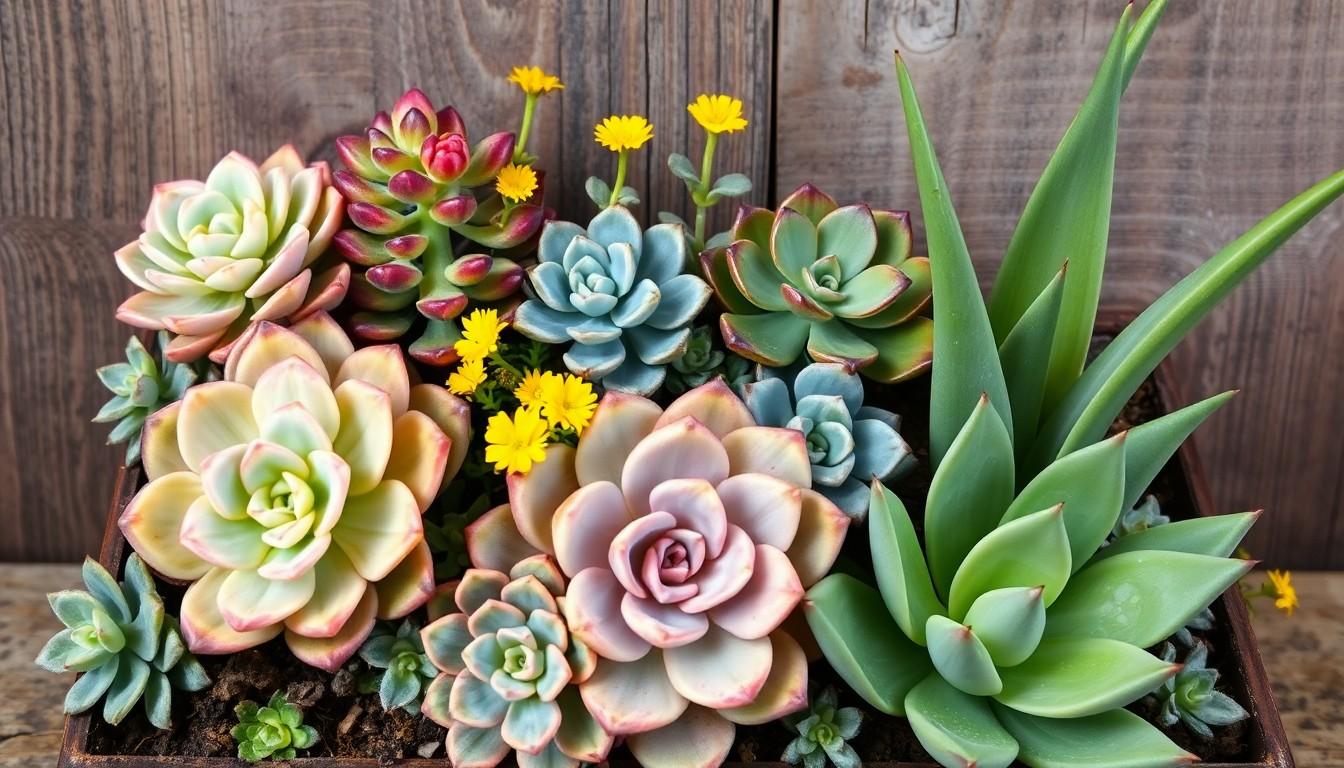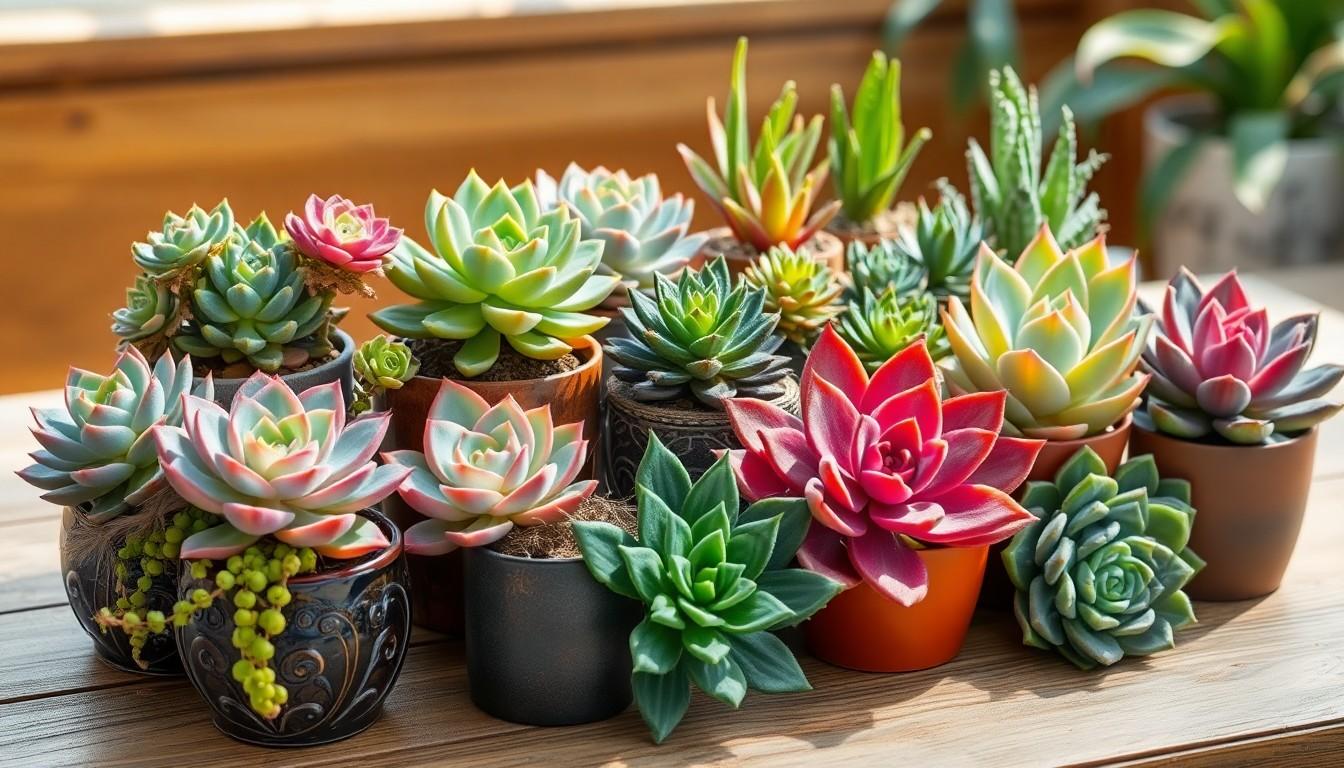Phone:
(701)814-6992
Physical address:
6296 Donnelly Plaza
Ratkeville, Bahamas.

Succulents are the rock stars of the plant world—low maintenance, stylish, and ready to brighten up any space without demanding too much attention. With their quirky shapes and vibrant colors, these little green wonders are perfect for anyone looking to add a dash of personality to their home or office. But with so many types out there, how does one choose the right succulent for their collection?
Succulents are a diverse group of plants known for their thick, fleshy leaves and stems. These adaptations allow them to store water, enabling survival in arid conditions. Various types of succulents thrive in distinct climates, showcasing unique shapes and colors.
Common categories of succulents include:
Different succulents possess specific care requirements. Some enjoy strong sunlight, while others thrive in partial shade. Watering needs vary, with some succulents preferring dry soil between waterings. Overwatering can lead to root rot, a common issue.
Caring for succulents promotes longevity and vibrancy. They often flourish in well-draining soil, which prevents excess moisture. Fertilization is typically unnecessary, but minimal feeding during the growing season may encourage growth.
The aesthetic appeal of succulents extends to their incredible variety. Each type contributes to its environment, enhancing decor with unique textures and colors. Selecting the right succulent involves consideration of preferences and growing conditions.

Succulents exhibit a wide variety of forms and colors, enriching spaces significantly. Here are some common types of succulents, each with unique traits and care needs.
Echeveria features rosette-shaped leaves that come in various colors including green, blue, and purple. Often, their attractive blooms appear in spring and summer, adding to their charm. These plants thrive in bright, indirect sunlight and require watering only when the soil dries out completely. Regular checks for pests are vital, as they can sometimes attract mealybugs or aphids.
Sedum consists of diverse species, known for their hardy nature and ability to flourish in poor soil conditions. They vary in size and color, with some types having trailing growth, perfect for hanging arrangements. Full sun exposure aids their growth, while infrequent watering helps prevent over-saturation. Sedums often attract pollinators, enhancing outdoor gardens with lively activity.
Aloe plants, particularly Aloe vera, are noted for their medicinal properties alongside their ornamental appeal. Thick, fleshy leaves characterize them, often containing a soothing gel valuable for burns and skin irritations. They flourish indoors with bright light, requiring minimal watering. Aloe’s resilience makes it a popular choice for beginners and seasoned gardeners alike.
Haworthia presents rosette formations with thick, pointed leaves that often display intricate patterns. Some species resemble miniature agave, making them visually distinctive. These plants prefer indirect sunlight and thrive in drier conditions. Their compact size makes Haworthia ideal for small spaces or desk environments, contributing to low-maintenance plant collections.
Succulents feature distinct traits that set them apart from other plants. Their ability to thrive in challenging environments makes them popular among plant enthusiasts.
Water storage plays a crucial role in succulent survival. Plants like Aloe and Echeveria have thick, fleshy leaves that act as reservoirs, enabling them to retain moisture over extended periods. During dry spells, these plants draw on their stored water, which helps them endure drought conditions. The specialized structure of their tissues prevents excessive water loss, making these plants resilient. Certain succulents, such as Sedum, adapt to poor soil conditions while efficiently managing water reserves. By utilizing these adaptations, succulents can flourish in arid climates where many other plants struggle.
Leaf shapes and sizes vary significantly among succulent species. Echeveria exhibits rosette formations, contributing to its striking visual appeal. Meanwhile, the elongated leaves of Haworthia create an interesting contrast with the rounded shapes found in Crassula. Variability in leaf sizes provides diverse textures, enhancing the aesthetic value of these plants. Succulents like Sedum come in a range of heights, from low ground covers to taller varieties. This variety enables individuals to create dynamic arrangements that suit their personal preferences. The unique characteristics of succulent leaves not only serve practical purposes but also add to the plant’s decorative allure.
A types of succulents chart serves as a valuable tool for identifying various succulent species, facilitating easier care and selection. This chart enhances understanding of the broad category of succulents and their unique traits.
Succulents can be categorized based on various criteria. Popular methods include classification by family, growth habits, and environmental needs. For instance, family classification groups plants like Echeveria and Crassula together, highlighting their shared characteristics. Growth habits enable differentiation between upright types and trailing varieties, affecting their placement in arrangements. Environmental needs focus on light and water requirements, allowing for tailored care based on individual species. Utilizing these categorization methods promotes informed selections and better plant health.
Creating a visual representation of succulent types enhances identification. High-quality images paired with concise descriptions effectively convey characteristics of each species. Incorporating elements like color variations, leaf shapes, and growth patterns fosters a deeper appreciation for diversity within succulents. A structured table format may present crucial information clearly, showing care requirements alongside visuals. Engaging visuals stimulate interest and encourage users to explore specific types while simplifying the selection process, ultimately resulting in healthier plants.
Choosing the right succulent can transform any space into a vibrant oasis. With the diverse types of succulents available each offering unique characteristics and care requirements, it’s essential to understand individual needs. The types of succulents chart serves as a practical guide for enthusiasts and newcomers alike, simplifying the selection process.
By utilizing this chart, individuals can make informed decisions that align with their aesthetic preferences and environmental conditions. Proper care and attention to each plant’s specific requirements can lead to thriving succulents that enhance any home or office. Embracing the beauty and resilience of these remarkable plants opens up endless possibilities for creative arrangements and personal expression.